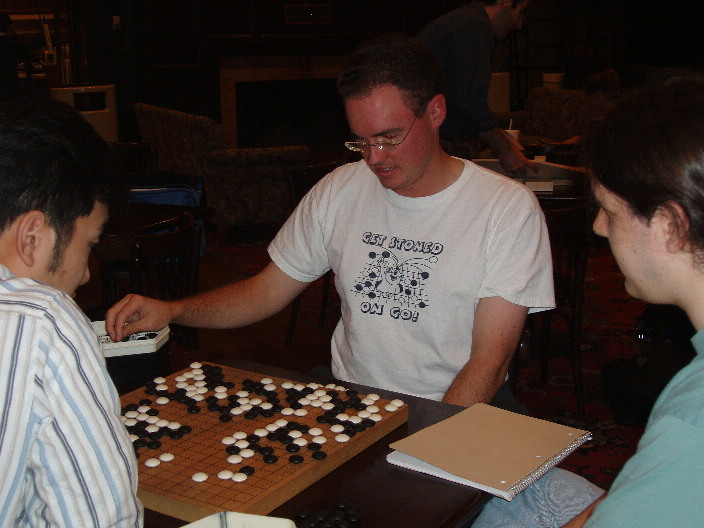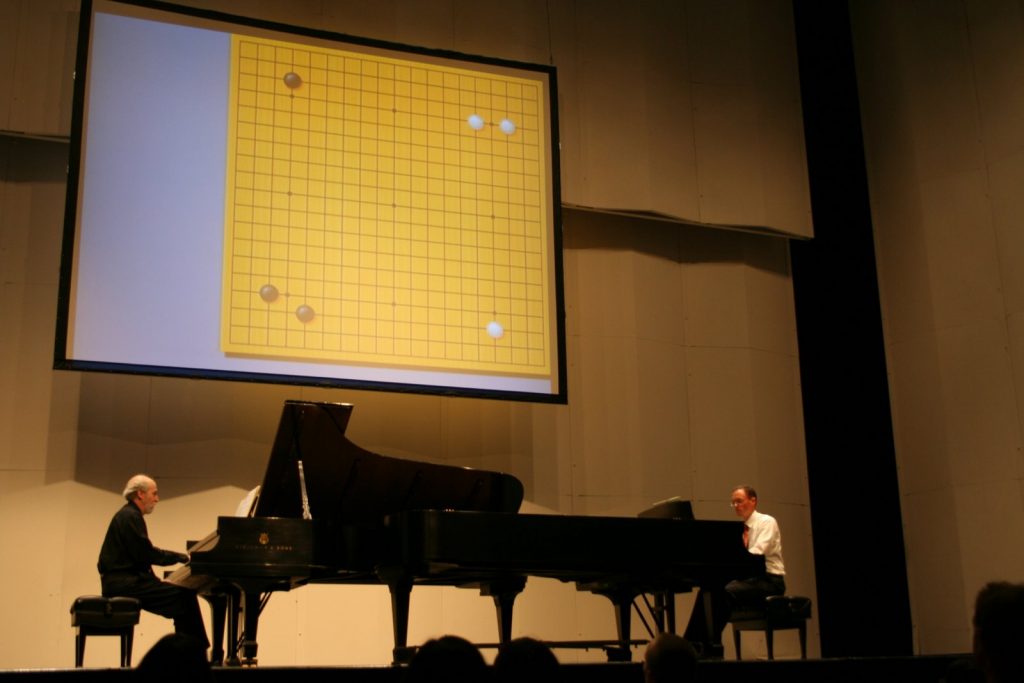|
I have been the president of the Penn Go Society in Philadelphia and remain a great go enthusiast here in Ann Arbor. I hope this small website might help encourage new players to give this extraordinary game a try. A lot of helpful information for newcomers, especially in the United States, can be found at the American Go Association website. The short essays below come from my experience in promoting the game to newcomers. After the pandemic subsides I hope to get more involved in the go community again. The achievement of Artificial Intelligence applied to go is a stunning breakthrough that many of us couldn’t have predicted in the mid 2010s when I was an active player. I count myself among those who doubted this would happen so soon. In fact I was quoted by Christopher Chabris in this Wall Street Journal article not long before AlphaGo burst on the scene. |

I took up go rather late in life (I was nearing 30) and since discovering it, I more or less dropped chess for a time to probe the deeper mysteries of go. If you are a chessplayer who is feeling stuck or wants to try something new, rich, and rewarding, I recommend it very highly. Chess is certainly a great game, but I want to discuss some problems I experienced in chess that are no issue in go:
White advantage
In chess games, one player always has the advantage right from the start. This can be especially troublesome with unequally matched players, where for instance a stronger Black player might have to play inferior moves to fight for a win, and run afoul of the truth of the position. Tournament pairings that randomize colors definitely introduce an element of luck into the results. A go game is won by the player with more points. While the first player starts with the initiative, the second player is traditionally awarded a compensation, called “komi,” in the 5 to 8 point range, so that neither player is clearly more likely to win the game than the other. Komi doesn’t yield exactly a 50% winning probability but it is close enough that Go players rarely have a strong preference for color.
Draws
High level chess is full of “GM draws” without serious fighting; it is a common and constant complaint that well-played chess games with accurate play just lead to equal positions. In modern go there are no draws, because komi includes a half-point to make this impossible. There is the remote possibility of a kind of “threefold repetition of position,” a triple ko, but this is less than a one in a million chance. In high level games, a player who feels even slightly behind will take chances to create more complications, and it can take great skill to refute such risky play. This naturally leads to exciting battles.
Too many Openings
In chess there is a massive amount of opening theory; keeping up in detail with the developments in your favorite special opening can be a huge practical advantage. In go, while there are some standard corner sequences, some of them exceedingly complex, the local choice of pattern (joseki) relates to the whole board strategy. Thus, one can’t simply specialize in just a few to the exclusion of all others without incurring a global disadvantage. In general, when playing go it is fairly easy to avoid a pet variation or prepared analysis without making serious concessions.
Not enough scale and variety
I found after years of tournament play and study that many chess games fall into certain standard types of positions; I found as I wandered around a tournament hall that many games that I observed looked pretty similar to games I had seen before. I can’t think of one full-board go game I’ve played whose course resembled any other, because go is as if in a higher dimension, like many smaller chess games going on at once, and the way they relate to one other adds a significant layer of extra complexity and apparent unpredictability.
Boring passive opponents
Contrary to what one often reads, a reasonably experienced chess player with no ambitions who avoids creating weaknesses is very difficult to beat, particularly with the Black pieces. This can be frustrating in a must-win situation in a tournament. In go, this isn’t an issue at all; the person who yields to every challenge will make one concession after another, and can only hope to win a game with a high handicap. It’s the players who fight with you at every turn who give trouble, but this is a much more exciting and inspiring scenario to confront.
Poor pairing systems
The way the USCF runs open Swiss system tournaments may be OK in some respects for determining a winner but it’s no way to produce interesting or valuable games of chess. I played in many chess tournaments next to people my own strength; I saw them all the time but was rarely ever paired against them. I was paired frequently against the same weaker opponents. Go tournaments use a “Swiss-McMahon” system that begins every tournament with you playing an equally matched opponent. You move up or down from there based on your results.
Unequal opponents
In chess it isn’t much fun playing against a much weaker opponent, feeling that anything other than a win would be a disaster, while the win will prove nothing and teach you little about the game. It’s also not much fun playing a much stronger opponent getting beat up badly like the clearly weaker boxer in the ring. In go, there’s an effective handicap system that makes these kinds of mismatches fun and interesting, giving both sides reasonable chances to win. Chess has a history of odds games too, and they are probably underestimated these days, but the game itself seems not to lend itself comfortably to unequal matches. In go, handicap games are commonplace and fun, and low handicap games are quite fair and also widespread in many tournaments.
If you’d like to take up go from the beginning, I will make a few suggestions from my personal experience.
Starting from scratch
There are two easy ways to learn the rules. One is to download The Way to Go and follow its step-by-step course. Another way is to use Janice Kim’s series Learn to Play Go. Both of these will work you through the rules and basic ideas a little bit at a time; you can go at your own pace and there isn’t too much information to absorb at one time. Although the possibilities of go are great, the rules are pretty simple and elegant.
At this stage, you will want to play some games on a 9×9 board. It is best just to play a lot of games fairly quickly and get some experience, some feeling for the flow of play, and some instinct for dealing with typical situations. It is ideal, of course, to make another friend and go sparring partner, but if you have trouble finding a carbon-based opponent, you can find a silicon one: simply download SmartGo for iphone, or GnuGo, or igowin, and you’ll have a pretty reasonable opponent. I actually started this way, playing igowin! I didn’t try playing people until I was able to beat the primitive computer program on a 9×9 board.
You will find that doing some exercises will be useful too. I highly recommend Kano Yoshinori’s series Graded Go Problems for Beginners, and Volume One will be perfect for you at this stage. Go over it several times to be sure you understand all the problems thoroughly.
Moving on to bigger boards (30k-20k)
A good intermediate step is to play on a 13×13 board and feel the greater expanse of room on the board, and the slower pace of the game. At this point you could well be working on volume two of the Graded Go Problems. You can get some more theory from the later volumes of Janice Kim books. But mostly you will want to search out different opponents and playing more games. This might be a good time to sign up for one of the Internet Go Servers: IGS (Internet Go Server) and KGS (Kiseido Go Server).
The time-honored method to improve is to play games, and have them reviewed. Try to join a local club, and join the American Go Association; play in a tournament. If you don’t have access to a teacher or a strong player near you, there’s a great resource called the Go Teaching Ladder. On there, you can submit your online game for review by a stronger player, for free, and remarkably enough, there are plenty of people out there kind enough to do this for you! You might also find it interesting to download and play over reviews of games by other people of your level; you should see many mistakes pointed out that you are making too.
From 20k working towards single-digit kyu:
This is a tricky time in one’s development, because one needs some theory at this stage, but the literature is unfortunately sparse in material for people of your level. The beginning books are too basic for you, but most of the supposedly “Elementary” books may be a little hard to grasp with your limited experience, especially since most of them start to use some very technical vocabulary.
From the Elementary Go Series, there are two books that are really important: Tesuji and Life and Death. If you are serious about improving, you should really spend some time with these two; reread them a few times and try not just to learn the material but really master it. This is the real foundation of go strength. There are many collections of problems readily available, for example on SmartGo and at goproblems.com.
From the standpoint of middlegame strategy (the essence of the game) I would highly recommend Michael Redmond’s ABC’s of Attack and Defense. This book really opened my eyes to what go is all about, and it’s written in very simple language but has many interesting examples and sharp tactics in it. I’d recommend getting to know this material very well.
Finally, if you’d like to have a better idea about the opening, you can get that from either “In The Beginning” from the Elementary Go Series, or from Opening Theory Made Easy. Joseki books are going to be a little tough to follow at this stage, and the English literature is a little weak on the subject. The easiest way to start is probably “38 Basic Joseki”, from the Elementary Go Series, but this book is incomplete and out of date. You could also use the handy downloadable Kogo’s Joseki Dictionary.
Finally, a treasure trove of extremely fine go instructional material at any level can be found at Guo Juan’s Internet Go School.

Playing “A Game of Go,” for two pianos, with Haskell Small – fellow pianist-composer, go enthusiast, and composer of this work – during opening ceremonies of the 2008 US Go Congress.
© Copyright 2002-2023 Matthew Bengtson
Graphic designs by Mike Samuel Graphics | Webdesign by ZebWebDigital.com